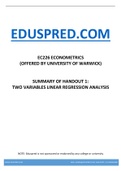Summary
EC226 Econometrics: Summary of Handout 1 (Two Variable Linear Regression Analysis)
- Course
- Institution
This econometrics revision guide is for the students taking EC226 Econometrics at University of Warwick. This has the summary of Handout 1, Two Variable Linear Regression Analysis. This document is created by 'Eduspred'
[Show more]



